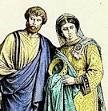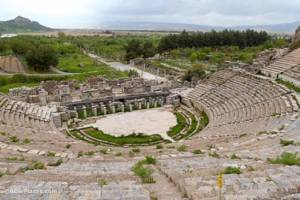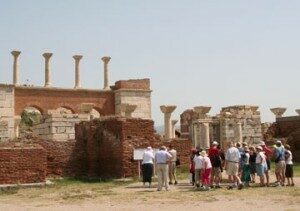EPHESIANS
Author: Apostle Paul.
Date: AD 62, during Paul’s first imprisonment (house arrest) for 2-years (Acts.28:30). Tychicus carried this letter to Ephesus. Colossians, Philippians and Philemon were also written during this period of house arrest.
Place of writing: Rome
To whom written: To the believers in the church of Ephesus.
Background:
Ephesians church is mentioned in Revelation. We first read it in when Paul visits it (Acts. 18-20). Paul writes 1 and 2 Timothy addressing to Timothy in Ephesus. Apostle John wrote 3-letters when he was in Ephesus, because John settled there with Mary the mother of Jesus and their graves are still there. During Apostle Paul’s ministry in Ephesus; many worshippers of Diana switched over their faith to the true and living God, the Lord Jesus Christ. Aquila and Priscilla lived in Ephesus for quite some time (Acts 18:18-21). The church was well established. In AD 431, there was a council held in Ephesus.
Sometime after Paul’s departure, Apollos visited the city (Acts 18:24-28). Apollos was an Alexandrian Jew who had been instructed in the way of the Lord, but he knew only the baptism of John. As his knowledge was imperfect, Priscilla and Aquila, upon hearing him speak publicly, took him aside privately and explained to him the way of God more accurately.
After this, “Apollos desired to cross over to Achaia and the brethren at Ephesus wrote, exhorting the disciples to receive him”. The use of the word “brethren” indicates there are others at Ephesus who are now Christians besides Aquila and Priscilla. The church was probably still quite small and may possibly be meeting in the home of Aquila and Priscilla.

Aquila and Priscilla
History:
In 133 B.C., Ephesus came under direct control of the Romans. During the first century A.D., the city was the capital of the Roman province of Asia. It was famous for its trade, art, and science, but it was even more renowned for its Temple of Diana (Greek Artemis), which was considered one of the 7- wonders of the world. It was a building of iconic architecture, 425-feet long and 220- feet wide. It was supported by 127- marble columns that were 60-feet high. Thirty-two of these were beautifully carved. Some of the stones from this temple are on exhibit in the British Museum. In modern times this temple is in complete ruin, as is the city, and not a living soul resides within its walls.
The church had rich heritage. Aquila and Priscilla had first introduced the Gospel to this city (Acts.18:18-19) and soon joined by the powerful preacher Apollos (Acts 18:24-26). All these 3-people laid the groundwork for Paul. Apostle Paul first stopped briefly in Ephesus near the end of his 2-missionary journey (Acts.18:19-21), but his real ministry in Ephesus took place on his 3-missionary journey (Acts19:5). Paul laboured for the church for 3-years (Acts. 20:31)
Later Timothy served as a pastor of the church at Ephesus (1 Tim.1:3), Onesiphorus (2 Tim.1:16,18) and Tychicus (2Tim.4:12) also served the church of Ephesus. Apostle John spent the last 10 years of his life at Ephesus from which he wrote 1,2 and 3 John Epistles. From here John was arrested and exiled to Patmos.
During Paul’s ministry, the gospel had convicted many people who were practicing magic and witch craft. They all brought their books and burnt them which was estimated to cost around 50,000 pieces of silver (Acts.19:18-19). The most important thing of Ephesus was the city was the home of goddess Artemis also called Diana (Acts. 19:27,35) which had become one of the ancient 7-Wonders of the World. During Paul’s ministry, the silver smith Demetrius, the craftsmen began a riot that threw Ephesus into chaos (Acts.19:23-41).
Ephesus had a population of 2.5 to 5.0 lacks population. It had a theatre which is estimated to accommodate 25,000 people. The city hosted Athletic events rivalling the Greek Olympic games. In the midst of this pagan city which had the goddess Artemis, a small faithful group of Christians existed to which Christ addressed this first of the seven letters.
Ephesus is located about 3-miles inland from the Aegean Sea in the Cayster River valley. The harbour, which frequently silted up, made an excellent seaport. Three important roads met at Ephesus. One brought trade from the east via Colossae and Laodicea. One came from Galatia via Sardis and brought trade from Asia Minor. The third important road was to the north. This system of roads, coupled with the excellent seaport, made Ephesus the fourth greatest city in the Roman Empire after Rome, Alexandria, and Antioch, with a population of more than 250,000.

Great theatre in Ephesus

The Basilica of St. John believed to have buried under the ruins.